Archive for the 'Hydro' Category
Ocean Mechanical Harvest in Practice

From Renewable Energy News:
A pilot project in New York’s East River is evaluating the use of underwater turbines to generate electricity. If the project bears fruit, the technology could have widespread applications. The effort, formally called New York’s Roosevelt Island Tidal Energy Project, is being conducted by Verdant Power and the New York State Research & Development Authority.
As part of the project, Con Edison is using the electricity produced by the turbines to power a grocery store and parking garage on Roosevelt Island, which sits adjacent to midtown and upper Manhattan in the middle of the East River.
For information more information on ocean energy harvest, check our archives on ocean mechanical and thermal conversion posted last week.
1 comment
Mechanical Ocean Energy Conversion, Part II
Having already explored Ocean Thermal Energy Conversion and the reservoir approach to mechanical ocean energy harvest, it’s time to look at the wave action harvest technologies and companies.
This is pretty simple, the energy in the ocean (generated by wind, convection, and lunar gravitational pull) is expressed in waves and currents. One can clearly see the power of waves over time by looking at any coastline or by looking at the aftermath of a tsunami.
The methods for harvest of this energy are also pretty simple. In the case of a current, it’s the same as wind, a turbine is used mounted vertically or horizontally which is connected to a generator. A vertical axis ocean turbine from Blue Energy is illustrated below:
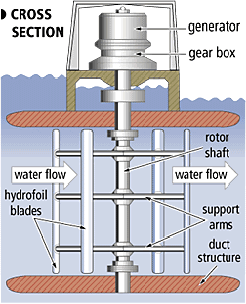
An artist’s rendering of a vertical axis turbine is depicted below:
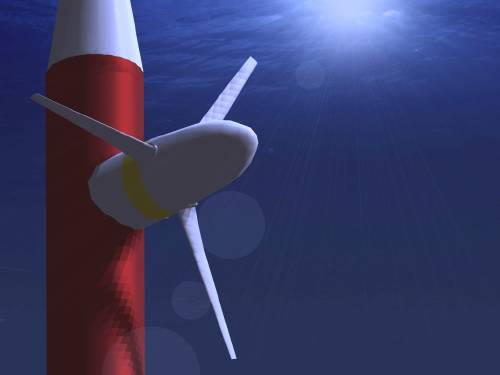
These are accessible technologies and familiar to anyone who has ever seen a windmill in operation. There are some other, more exotic harvest technologies though as well. For instance, the oscillating water column, depicted below:
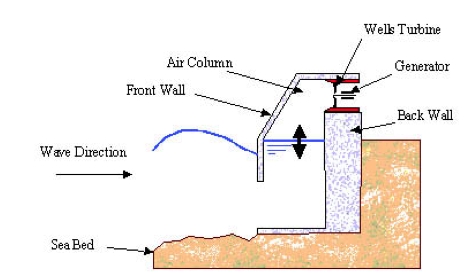
As the wave action occurs, a column of air is compressed in a tight space creating pressure. This air is driven through an efficient turbine as the wave comes in, and sucked back through the same turbine as the wave goes out when a vacuum is created as the wave retreats. This application could be applied on shore or in a floating device.
Another interesting class of harvest device are the pendulors. As the name suggests, there is a pendulum type device that is moved back and forth by wave action. The pendulum (I tend to think of it more as a paddle) is connected to a hydraulic pump which forces a working fluid through a turbine. This application may also be shore-based or floating. An illustration of a shore-based system is available below:

Since the ocean comprises the vast majority of the Earth’s surface area and has nearly unlimited energy, both mechanical and thermal, it makes sense to explore utility scale harvest of the resource. There are some efforts underway, but they pail in comparison to the amount of money being poured into wind and solar projects. This is an interesting opportunity for the right kind of investor….
Mechanical Ocean Energy Conversion
Yesterday we explored Ocean Themal Energy Conversion and today we’ll move to mechanical harvest of the ocean’s energy. In the past, we’ve done an entry on tidal barrage which is one form of mechanical conversion using a reservoir system.
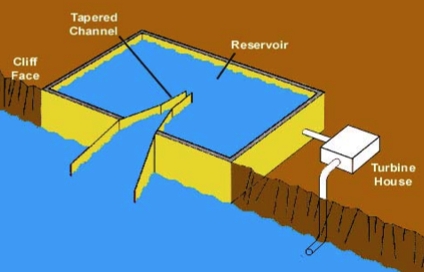
Illustration of channel reservoir system
Fundamentally there are two ways to mechanically harvest ocean energy, using the wave motion and/or using tidal action. One of the simplest devices is the channel reservoir system which uses tidal action and wave action to capture water in a reservoir then uses gravity to release the water through a turbine.

Example of floating reservoir system (Seapower)
Commercial interest in reservoir systems has existed for some time with Sweden’s Seapower, Norway’s Norwave, Denmark’s Waveplane International, and Wave Dragon. The animated gif below shows the Wave Dragon floating platform that is intended to capture water from the waves breaching the outer rim of the device, holding the water in a reservoir, then allowing it to drain through a turbine generating electricity.

We’ll look at other harvest technologies in future entries.
Thermal energy harvest
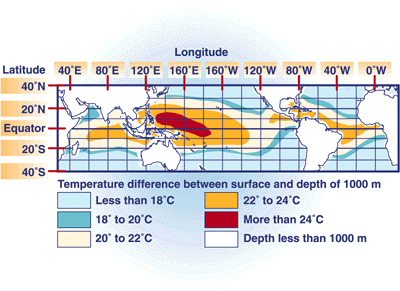
There are principally two ways to harvest energy from the ocean, mechanically (think waves and tides) and thermally (think solar energy stored in the water and temperature difference between deep ocean and the surface.) Ocean Energy Thermal Conversion (OETC) has been around well over 100 years and works either in an open or closed cycle (works just like organic rankine cycle geothermal systems.) The prospects of OETC were first proposed in 1881 by Jacques Arsene d’Arsonval, a French physicist.
The concept was first proved in 1930 by Georges Claude off the coast of Cuba with a 22 kilowatt unit and later off the coast of Brazil with a 10,000 ton cargo vessel. Both plants were destroyed in storms before either had demonstrated net power production (producing more energy than the system consumes during operation.) In 1956 the French made another attempt at OETC off the Ivory Coast planning a 3MW facility. While construction was started, it was never completed due to high costs.
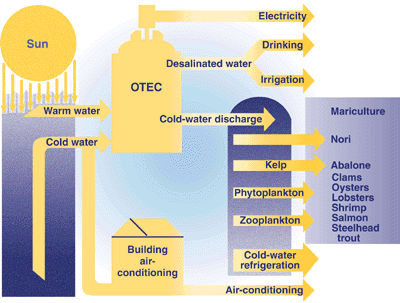
Illustration of an Ocean Thermal Energy Conversion plant
The first oil crisis spurred the US into the act in 1974 when the Natural Energy Laboratory of Hawaii Authority was established. The group created a 52 kilowatt mini-OETC plant that was moored a couple of miles off the coast that was a net producer (15 kilowatts,) enough to operate the ship’s electrical systems. In 1999, the group successfully tested a 250 kilowatt system. Both of these experiments were closed or binary approaches.
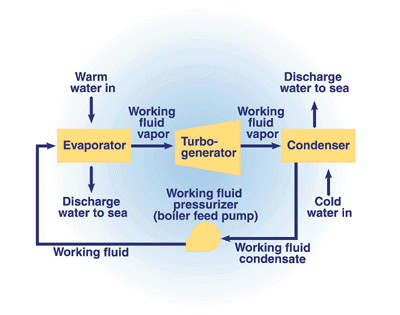
OTEC Closed Cycle Plant Illustration
In 1984, NELHA created a 50 kilowatt open system, boiling seawater at low pressures, that had efficiencies as high as 97%. It turns out the open approach also has the interesting by-products of nearly pure fresh water, very cold sea water, and the solids left by evaporation which can be rich in up to 57 different trace minerals. This could have a use in desalination, mining, and aquaculture in addition to simply producing power.
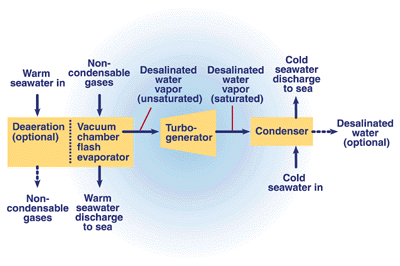
OTEC Open Cycle Plant Illustration
The National Renewable Energy Lab has ceased all work in this area, this isn’t uncommon in today’s DoE as they seem to only care about nuclear power and the elusive “clean coal” technology. But, private firms are continuing to explore this concept and seem to be moving ahead slowly. NELHA remains the only site with active use of OETC, though it is relatively small scale and used principally for aquaculture.
Commercial development is still underway with proposals for 100MW sea power plants by Sea Solar Power Inc. and SEA02’s proposal for an ocean-based, sustainable city called Townsville.
Ocean energy harvest
This week we’ll tour the advances happening in ocean energy. Why? Check the map out below for one reason:
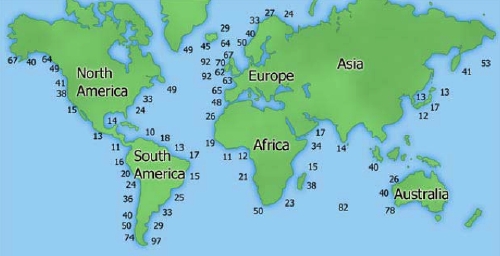
The figures above indicate potential power available in kilowatts per meter. As is clear from the map, there is an enormous amount of energy in the ocean simply waiting to be harvested. Given that the Earth’s surface is 70% covered in ocean, this is a vast untapped energy resource. In future entries, we’ll delve into the major harvest technologies, both mechanical and thermal, and we’ll take a look at the companies attempting to make a commericial success in this area.
Stay tuned for more information.








